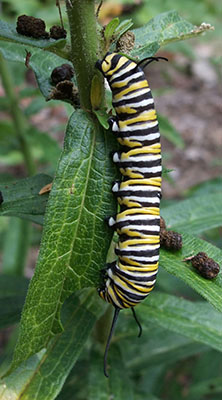
The monarch butterfly is one of the most widely recognized and celebrated butterflies in the U.S. For many of us, the love affair started in grade school when we learned about the monarch’s migration and their giant winter clusters in Mexico.
The U.S. has two populations of monarch butterflies – an eastern and a western population. The western population migrates to southern California for the winter. The eastern population migrates to Mexico for the winter. Monarchs are the only butterflies that have an annual migration cycle where the same individual has both a northern and a southern migration.
The monarchs we see in Kentucky are part of the eastern population. In mid to late August, monarchs in the north will begin migrating south. These butterflies have never been to Mexico. They are the great and great, great grandchildren of the butterflies that left Mexico in the spring. Scientists still aren’t sure how the butterflies know how to get to the overwintering site since they have never been there. That’s one of the exciting things about monarchs – there is still so much we can learn about them.
As the monarchs move south, they begin to cluster into larger and larger groups. The butterflies will stop to sip nectar from a variety of flowers as they migrate and will spend the night roosting in undiscovered locations. When they get to Mexico, the butterflies spend the winter in the huge roosts that have been so well publicized. In the early spring, the butterflies will mate and begin their journey north again.

The butterflies that leave Mexico will only live a few weeks after they begin reproducing. These butterflies never make it beyond the southern U.S. on their northward migration. However, as they are migrating north, the females are laying eggs on milkweed plants. The female will lay one egg on the underside of a leaf, then move on and lay another egg on another leaf. A single female can lay several hundred eggs in her lifetime.
The eggs laid by butterflies that overwintered in Mexico are considered Generation 1 and form the basis for the annual migration cycle. When these eggs hatch, the caterpillars will spend several weeks munching on milkweed before metamorphosing into a mature butterfly. The mature butterflies will mate and continue the journey north.
Once again, the mature butterflies will only live a few weeks. As they move north the females, like their mothers, lay their eggs on milkweed plants, thus giving birth to the next generation of monarchs. These eggs are known as Generation 2 and are the grandchildren of the butterflies that left Mexico. In Kentucky, our spring monarch butterflies are members of Generation 2.
Like their parents and grandparents, Generation 2 butterflies will mate and continue moving north before dying a few weeks later. The Generation 2 butterflies will lay Generation 3 eggs. Butterflies that begin life as early Generation 3 eggs will migrate further north and lay Generation 4 eggs. The reproductive systems for butterflies that come from late-season Generation 3 eggs and all Generation 4 eggs are set to “pause.” These are the butterflies that will make the southern migration to Mexico, overwinter there, become sexually mature in the spring, and begin the cycle over again as they migrate out of Mexico.
A group called Journey North has set up a tracking system that allows people all across the country to report monarch sightings. The reports are loaded onto an interactive map that anyone can access. The reports are also used by scientists to track the migration and monarch populations. You can learn more about the project and report your own monarch sightings at the Journey North Monarchs website.


This article was part of Shannon’s original Kentucky Pollinators and Backyard Wildlife blog which evolved into the blog for Backyard Ecology.

Backyard Ecology: Exploring Nature in Your Backyard
Nature isn’t just “out there.” It’s all around us, including right outside our doors. Hi, my name is Shannon Trimboli, and I am the host of Backyard Ecology. I live in southcentral Kentucky and am a wildlife biologist, educator, author, beekeeper, and owner of a nursery specializing in plants for pollinators and wildlife conservation. I invite you to join me as we ignite our curiosity and natural wonder, explore our yards and communities, and improve our local pollinator and wildlife habitat. Learn more or subscribe to my email list at www.backyardecology.net.

Leave a Reply